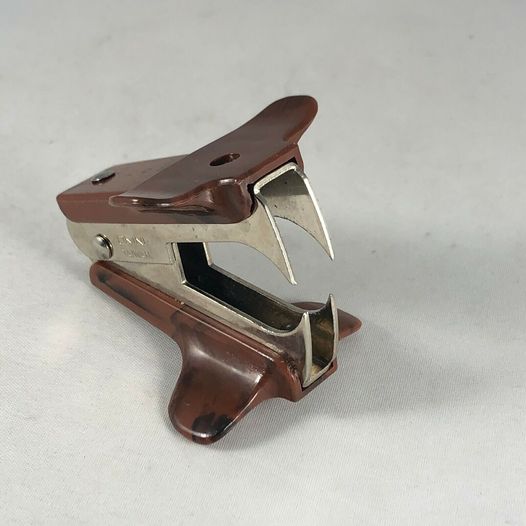The vintage staple remover, a small yet indispensable office tool, holds a unique place in the history of office supplies. Though often overshadowed by its more prominent counterpart, the stapler, the staple remover has been quietly aiding office workers, students, and home users for decades. Its journey from inception to modern usage reflects a fascinating evolution in office efficiency and design.
The History of the Vintage Staple Remover
The staple remover first made its appearance in the early 20th century, around the same time as the development of the stapler. Before its invention, removing staples from paper was a cumbersome task, often resulting in damaged documents. The need for an efficient way to extract staples without harming the paper led to the creation of the staple remover.
The first patent for a staple remover was filed in 1933 by William G. Pankonin, an inventor who recognized the necessity for a dedicated tool to facilitate staple removal. This early design was simplistic, often resembling a claw or tong-like device that manually pulled out staples. As the demand for more efficient office tools grew, so did the development of staple removers.
In the 1950s, the design of the staple remover underwent a significant transformation. The now-iconic “jaw-style” remover, often credited to Joseph A. Foitle, became popular. This design featured two metal jaws with serrated teeth that could easily slide under a staple, gripping it firmly and removing it with a simple squeeze. This innovation made staple removal faster, easier, and safer for documents.
Usage of the Vintage Staple Remover
The vintage staple remover was designed to perform one specific task: extracting staples from paper. Its usage spread rapidly across offices, schools, and homes due to its straightforward design and effectiveness. The tool’s small size made it convenient for storage in desk drawers, pencil cases, and office kits.
To use the vintage staple remover, the user simply aligned the jaws with the staple, applied pressure to the handles, and gently pulled the staple out. This simple operation helped prevent tears or holes in the paper, maintaining the integrity of important documents.
Beyond its primary function, the staple remover also found unconventional uses. It was occasionally employed to open envelopes or as an impromptu tool for prying open small items, showcasing its versatility and durability.
The Legacy of the Vintage Staple Remover
The legacy of the vintage staple remover lies in its enduring relevance and design simplicity. Despite advancements in office technology and digital documentation, the staple remover remains a staple (pun intended) in office environments around the world. Its role in preserving documents and easing administrative tasks ensures its continued presence in modern workplaces.
The vintage staple remover is often celebrated for its ergonomic design and efficiency. Collectors and enthusiasts appreciate the aesthetic charm of older models, which often feature distinctive metal finishes and unique design elements. These vintage tools are now considered collectible items, with some models gaining significant value among collectors of antique office supplies.
Moreover, the staple remover represents a broader legacy of innovation in the realm of office tools. It symbolizes the shift towards greater efficiency and the desire to make everyday tasks more manageable. The enduring popularity of this simple device is a testament to its effectiveness and the timeless appeal of tools designed with both form and function in mind.
Conclusion
The vintage staple remover, though a small and often overlooked tool, has played a significant role in the history of office supplies. From its early inception to its modern legacy, the staple remover has simplified the lives of countless individuals, preserving documents and improving efficiency across various settings. Its enduring appeal lies not only in its practicality but also in its ability to adapt to the changing landscape of office work, securing its place as an essential tool for generations to come.


